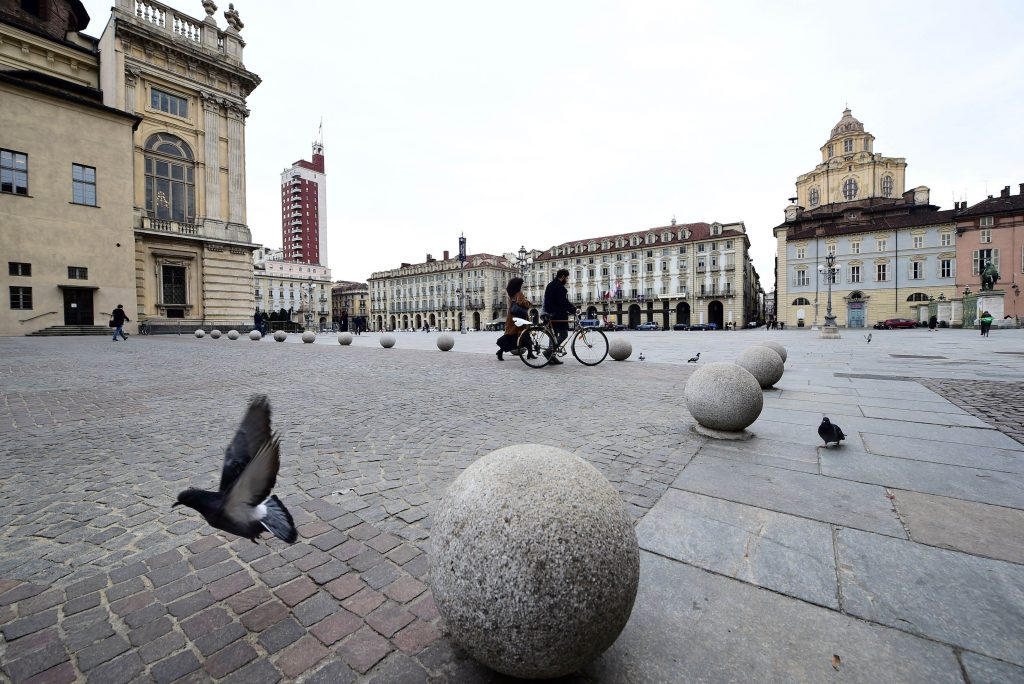Tucked away in the far northwest of Italy is a city where chocolate reigns. The residents of Turin have been creating—and consuming—chocolate since the 16th century, culminating in a vibrant chocolate scene that now encompasses gourmet chocolatiers, pastry shops, cafes, gelato makers and experimental chefs.
I love Italy, and I love chocolate. So Turin was the ideal place for my vacation this past spring.
To tour Turin is to discover local chocolate dishes that have long flourished here while remaining relatively little-known outside the region such as bicerin, Turin’s own luscious hot chocolate featuring layers of espresso and whipped cream, and bonet, a cool, creamy, pitch-dark dessert that tastes like a chocolate-infused caramel pudding. Turin even has its own signature chocolate variation: gianduja, an aromatic blend of cocoa, sugar and hazelnut paste.
Federico Zanasi, executive chef of the Michelin-star Turin restaurant Condividere and a transplant from north-central Italy’s Emilia-Romagna, says the city’s chocolate scene reminds him of France’s Champagne region, where large brands of bubbly with international standing compete with small producers with niche followings. But chocolate is hardly a luxury here. For 2 euros (about $2.15), Torinese on their way to work can have a quick morning cornetto, an Italian pastry that can be dosed with gianduja in a heady riff on a chocolate croissant. And some top-of-the-line artisanal chocolatiers will let you choose a customized assortment of four or five pralines, priced by the kilo, for less than 5 euros.

Nutella connection
As legend has it, chocolate came to Turin in the 16th century, when Emmanuel Philibert, a duke of what became the Italian royal house of Savoy, celebrated his marriage to a French duchess with some exotic, Spanish-style chocolate. Later on, local chocolatiers were licensed to meet the demands of a growing chocolate craze. In the early 19th century, a British embargo of Napoleonic Europe forced local chocolatiers to supplement depleted cocoa stocks with the hazelnuts that flourish in the hilly terrain south of the city, creating gianduja. In the 1960s, gianduja finally went national, then international, when an entrepreneur from Alba, a town now at the end of one of Turin’s commuter train lines, began to market Nutella spread, which tastes like gianduja but contains other ingredients to give it the right consistency and to add to shelf life.
Compared with Nutella, the gianduja in Turin features less sugar, more chocolate, and hazelnuts sourced from one particular corner of Italy’s Piedmont region. Gianduja often gets shaped into triangular, foil-wrapped candies called giandujotti (or gianduiotti), which are a symbol of the city itself.
Turin’s chocolate makers, meanwhile, often market their own upscale spreads, which amount to gourmet alternatives to Nutella. I began my chocolate-themed holiday with a few spoonfuls from a jar from Venchi, a local premium chocolate brand. Heavy, complex, and nothing if not hedonistic, it was to Nutella what caviar might be to jelly beans.
The current standard-bearers of Turin’s chocolate tradition are the city’s roughly two dozen premium chocolatiers, ranging from brands with an international following, such as Venchi and Domori, to small artisanal makers displaying their pralines and dragées in hushed, understated outlets that resemble jewelry stores. Each chocolate maker, whether large or small, has an in-house method of doing gianduja, tweaking the precise ratio of chocolate to hazelnuts, and a portfolio of innovations, involving, say, saffron, or matcha, or obscurely sourced Sicilian pistachios.
Domori, a Turin brand dating back to the 1990s, is credited with bringing the rare criollo variety of cocoa back into use. It has its flagship store on Piazza San Carlo, a grand Baroque square, and I sampled its very chocolate-y giandujotti, along with small pralines flavored with black currant and rum. Then I went around the corner to Guido Gobino , where the giandujotti were more hazelnutty, and I was wowed by an earthy praline flavored with licorice, and a zingy perfumed praline that included apricot and cardamom.

Creative concoctions
Turin, for a few years in the 1860s, was unified Italy’s first capital, with the Savoys installed as the Italian royal family. Its immense squares, lavish monuments, portico-lined walkways, and elegant vistas have a grandiose quality. It is a showpiece of late Baroque architecture, thanks to the career of Filippo Juvarra , a Sicilian import, who festooned his churches and palaces with swirling spires and sumptuous domes.
With a small airport, and near the end of Italy’s high-speed network, Turin is miraculously free of mass tourism. But there is, it turns out, a chocolate-minded tourist trade, and I ventured over to Borgo Rossini, a 19th-century industrial neighborhood, to take a public tour of Guido Gobino ’s factory.
The company has been making chocolate since the mid-20th century, but got a relaunch in the 1990s as an artisanal producer. Gobino himself, now age 66 and sole owner, runs the brand with his son, Pietro Gobino , 24. In addition to shops in Turin and Milan, they supply chocolate to restaurants such as Condividere and to Alberto Marchetti , one of the city’s artisanal gelato makers.
After touring the factory—where temperatures run the gamut from tropical conditions suitable for tempering chocolate to the Arctic chill of rooms used to store finished pralines—I had a chat with father and son. It turns out they make six different kinds of giandujotti, and the father admits to eating about a pound of chocolate a day.
Known for experimentation, Gobino confided that his quest to combine Turin-style chocolate with other signature Italian ingredients has sometimes gone amiss. He has had luck creating giandujotti that include white truffles, another prized commodity from Piedmont, but nothing good came out of mixing chocolate with Parmesan cheese or balsamic vinegar.
Elsewhere, Piazza Duomo, a three-star Michelin eatery and Piedmont’s most celebrated restaurant these days, sources its chocolate from a small storefront in Turin’s Crocetta district, run by Gabriele Maiolani , a chocolatier who trained in France. The shop serves its own delicious coffee-infused take on bonet, which embeds amaretti biscuits into the chocolate custard, giving the dessert a trifle-like effect.
Across the Po River from the heart of Turin’s historic center is Peyrano, a quaint shop with tiles and trimmings dating back a century. John Elkann —a descendant of the Agnelli family, the Turin dynasty behind Fiat, and the chairman of automotive giant Stellantis —has invested in the brand, which once supplied Italy’s royal family. These days, it still attracts a deep-pocketed clientele, says co-owner and CEO Alessandro Pradelli . He recounted a special Easter-themed order the firm recently did for a Monaco family who needed a chocolate egg big enough for their child to crawl inside. I was impressed with Peyrano’s version of giandujotti, which seemed to strike just the right balance between chocolate and hazelnut.
On my last day in Turin, stuffed with chocolate in all its forms, I needed a hike. For energy, I had an affogato al cioccolato, or coffee with homemade chocolate gelato, at Maradeiboschi. The bustling cafe-gelateria on Piazza Carlo Emanuele II not only designs its own line of chocolates but roasts its own coffee. Then I made my way—by streetcar and railway, and finally on foot—to the hilltop Basilica of Superga, the jewel in the crown of Turin’s Baroque architecture, with several centuries of Savoys buried in the crypt.
The view beyond Turin, into the distant snow-covered mountains, might have inspired awe, or humility. But after days of delicious chocolate, the Alps appeared extravagantly sugar-topped and good enough to eat.
J.S. Marcus is a writer in Berlin. He can be reached at reports@wsj.com .



